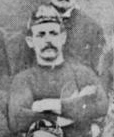 | |||||||||||||||||||||||||||||||||||||||||||||
| Date of birth | 1856 | ||||||||||||||||||||||||||||||||||||||||||||
|---|---|---|---|---|---|---|---|---|---|---|---|---|---|---|---|---|---|---|---|---|---|---|---|---|---|---|---|---|---|---|---|---|---|---|---|---|---|---|---|---|---|---|---|---|---|
| Place of birth | Auckland, New Zealand | ||||||||||||||||||||||||||||||||||||||||||||
| Date of death | 27 April 1925 | ||||||||||||||||||||||||||||||||||||||||||||
| Place of death | Wellington, New Zealand | ||||||||||||||||||||||||||||||||||||||||||||
| Occupation(s) | Police officer | ||||||||||||||||||||||||||||||||||||||||||||
| Rugby union career | |||||||||||||||||||||||||||||||||||||||||||||
| |||||||||||||||||||||||||||||||||||||||||||||
George Albert Williams (1856 – 27 April 1925), also known as Bully Williams, was a New Zealand rugby union player who toured with the 1888–89 New Zealand Native football team to the British Isles and Australia. [3] Williams was one of five non-Māori players in the Natives' side. [4]
Contents
Williams was born in Auckland in 1856, and did not start playing rugby until the age of 24. [2] He was a member of the Wellington club Poneke, and was selected for Wellington province from the club in 1886, 1887 and 1888. [1]
In early 1888, Joe Warbrick, a member of the 1884 New Zealand team that toured Australia, [5] started planning for a squad of Māori rugby players to tour the British Isles. [6] As Warbrick was scouting for players throughout 1888, his plans changed, and he decided to include a number of Pākehā (European non-Māori) in the side. [4] Eventually five Pākehā were included in the squad of twenty-six, and the side was consequently named the New Zealand Native football team. [7] [a]
At 32, Williams was the oldest player in the team, [7] and only joined a day before their first match. [8] The tour became the longest in rugby history; 107 matches were played during the 14-month tour, which had legs in Australia, the British Isles, and New Zealand. [9] Of these 107 matches, 74 were in the British Isles, [10] and an average of a game every 2.3 days on that leg. [11] Williams played in 53 of these, [12] scoring 12 tries in the process, [13] and captained the team on a number of occasions. [7] In total, Williams played at least 75 matches on tour (a number of team lists are missing). [12]
Williams played in all three of the Natives' "international" matches while on tour; a victory over Ireland, [14] a narrow loss to Wales, [15] and a controversial loss to England. [16] [b]
Williams retired as a player after the tour, but continued to be involved in the game as a referee. Along with two other players, he contributed to tour manager Thomas Eyton's Rugby Football Past and Present, published in 1896, [17] that gave an account of the tour. [18] He contributed a number of article to the New Zealand Truth before the departure of the 1924 All Blacks. [19] Outside of rugby, Williams was a police officer, and was involved in the arrest of the Maori spiritual leader Te Whiti o Rongomai. [2] He served throughout New Zealand, including in Wellington, Hastings, Invercargill and Marlborough. [2] [3]
Williams' native team cap, donated by his grandson Rob Williams, is held in the collection of the New Zealand Rugby Museum. [20]